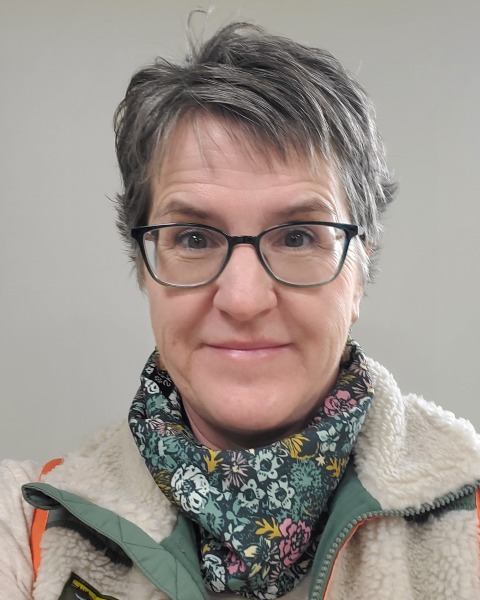Anatomy Education: Undergraduate Education Posters
Poster: Anatomy Education: Undergraduate Education Posters
162 - A Nontraditional Lab for the Traditional Student
Sunday, March 24, 2024
5:00pm - 7:00pm US EDT
Location: Sheraton Hall
Poster Board Number: 162
There are separate poster presentation times for odd and even posters.
Odd poster #s – first hour
Even poster #s – second hour
Co-authors:
There are separate poster presentation times for odd and even posters.
Odd poster #s – first hour
Even poster #s – second hour
Co-authors:
-

Laura Skinner, MAT
Assistant Professor
SUNY Cobleskill College of Agriculture & Technology
Cobleskill, New York, United States
Presenting Author(s)
Abstract Body : Introduction
Successful Anatomy and Physiology (A&P) undergraduate courses provide learning environments that maximize diversity of students’ thoughts through collaboration and development of critical thinking skills to apply their knowledge toward understanding clinical issues. I developed a jigsaw laboratory experience to help students understand the clinical roles needed to treat various cancers in the second week of lab for an A&P course. This followed lecture content that pertained to cancer activity at the cellular level.
Materials & Methods
This jigsaw was based around a lab of 10 students. Each group of five students were given a real cancer survivor story to read and discuss as a group for 25 minutes. A breast cancer and lung cancer survivor story were utilized for two groups. Each member of the group then selected one of five roles – pathologist, radiologist, oncologist, general practitioner, and surgeon. Each role had detailed assigned duties, so students could pick one that aligned with their own interest. Afterwards, students identifying with the same career role met together at a station to learn about their duties pertaining to each type of cancer.. After 30 minutes the initial multidisciplinary groups re-formed, allowing each student to share the information they learned, creating a multidisciplinary approach to the cancer type to which they were assigned. Specifically for each cancer type, students addressed prompts relating to: the patient’s experience; how the cancer type affects the tissues and organs it has invaded; the role of different healthcare providers in the diagnosis and treatment of the cancer; the application of understanding the disease to content learned in A&P.
Results
Our observations and anecdotal data pertain to one A&P course of 12 students. Creating group discussions early in the semester has lent to a cohesive lab group for the duration of the semester. Each student bringing knowledge to the table and having their voice heard has been invaluable. Students enjoyed this low stakes, investigative aspect of A&P. Using true survivor stories had a strong impact on the student’s commitment to this exercise. Expectations were manageable and its unique ask of students gained their commitment to each other and the course. Shortcomings included a weak inventory of radiology images for students. Also, cancerous tissue samples and slides available for the “pathologists” were a mismatch with each other and with the patient story cancers.
Conclusion
This lab activity met a holistic need in students’ educational experience. It was real, current and pertinent to today’s student. Future research will include a mixed-methods phenomenological analysis of students’ experiences based on theoretical frameworks of connectivism and transformation.
Successful Anatomy and Physiology (A&P) undergraduate courses provide learning environments that maximize diversity of students’ thoughts through collaboration and development of critical thinking skills to apply their knowledge toward understanding clinical issues. I developed a jigsaw laboratory experience to help students understand the clinical roles needed to treat various cancers in the second week of lab for an A&P course. This followed lecture content that pertained to cancer activity at the cellular level.
Materials & Methods
This jigsaw was based around a lab of 10 students. Each group of five students were given a real cancer survivor story to read and discuss as a group for 25 minutes. A breast cancer and lung cancer survivor story were utilized for two groups. Each member of the group then selected one of five roles – pathologist, radiologist, oncologist, general practitioner, and surgeon. Each role had detailed assigned duties, so students could pick one that aligned with their own interest. Afterwards, students identifying with the same career role met together at a station to learn about their duties pertaining to each type of cancer.. After 30 minutes the initial multidisciplinary groups re-formed, allowing each student to share the information they learned, creating a multidisciplinary approach to the cancer type to which they were assigned. Specifically for each cancer type, students addressed prompts relating to: the patient’s experience; how the cancer type affects the tissues and organs it has invaded; the role of different healthcare providers in the diagnosis and treatment of the cancer; the application of understanding the disease to content learned in A&P.
Results
Our observations and anecdotal data pertain to one A&P course of 12 students. Creating group discussions early in the semester has lent to a cohesive lab group for the duration of the semester. Each student bringing knowledge to the table and having their voice heard has been invaluable. Students enjoyed this low stakes, investigative aspect of A&P. Using true survivor stories had a strong impact on the student’s commitment to this exercise. Expectations were manageable and its unique ask of students gained their commitment to each other and the course. Shortcomings included a weak inventory of radiology images for students. Also, cancerous tissue samples and slides available for the “pathologists” were a mismatch with each other and with the patient story cancers.
Conclusion
This lab activity met a holistic need in students’ educational experience. It was real, current and pertinent to today’s student. Future research will include a mixed-methods phenomenological analysis of students’ experiences based on theoretical frameworks of connectivism and transformation.

